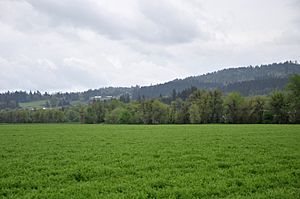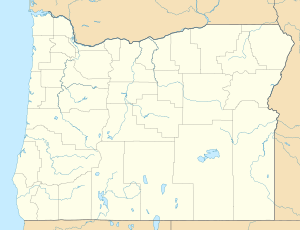Chehalem Creek facts for kids
Quick facts for kids Chehalem Creek |
|
|---|---|

Chehalem Creek hidden by trees along a farm field in Chehalem Valley
|
|
|
Location of the mouth of Chehalem Creek in Oregon
|
|
| Other name(s) | Chahelim Creek |
| Country | United States |
| State | Oregon |
| Region | Yamhill County |
| Cities | Newberg, Dundee |
| Physical characteristics | |
| Main source | East side of the Northern Oregon Coast Range Above Larsen Reservoir 6 mi (10 km) southeast of Gaston 409 ft (125 m) 45°22′11″N 123°07′30″W / 45.36972°N 123.12500°W |
| River mouth | Willamette River Newberg 62 ft (19 m) 45°16′49″N 122°58′33″W / 45.28028°N 122.97583°W |
| Basin features | |
| Basin size | 67.8 sq mi (176 km2) |
| Tributaries |
|
Chehalem Creek is a stream in Oregon, United States. It flows into the Willamette River in Yamhill County. The creek collects water from a large area, about 68 square miles (176 square kilometers).
The creek starts in the Northern Oregon Coast Range mountains. Its source is about 6 miles (10 km) southeast of Gaston, above Larsen Reservoir. Chehalem Creek then flows until it joins the Willamette River near Newberg. The name 'Chehalem' comes from the Atfalati Indian word Chahelim. This was the name of an Atfalati group in 1877.
Contents
History of Chehalem Creek
Early People and European Contact
The Che-ahm-ill people were a group of Kalapuya people. They lived in the Chehalem Valley when Europeans first arrived. They stayed there for many years. Later, most survivors moved to reservations, like the Grand Ronde Reservation.
In 1812, Pacific Fur Company traders came to the Willamette Valley. This was led by Donald Mackenzie. This was the first time Europeans met the Kalapuya people.
First European-American Home
Ewing Young was an early explorer. He came to Oregon in 1834. He built a home near where Chehalem Creek meets the Willamette River. This was across from Champoeg. His house is thought to be the first one built by European-Americans on that side of the river.
Nature and Wildlife Around Chehalem Creek
Forest Changes Over Time
When the first European explorers came in the 1820s, they saw large grasslands and oak forests. They also saw a lot of smoke from fires set by Native Americans. These fires helped keep the forests open.
After many Native Americans died from European diseases, the fires stopped. Over the next 150 years, Douglas fir trees grew thick in the area. Tree ring studies show that Native American fires were common until about 1848.
In the 1900s, logging companies cut down many trees. By 1902, most of the original lowland forests were gone. A 1947 report said that Yamhill County's forests were "seriously depleted." This meant there were not many trees left.
Fish and Water Quality
In the 1980s, people stopped adding hatchery-raised coho salmon and rainbow trout to the creek. Biologists worried that these fish might harm the wild, native fish.
In 1999, steelhead trout in the Willamette River were listed as threatened. This means they were at risk of disappearing. This listing continued in 2006 and 2011.
Several native fish live in the Chehalem Valley:
- Winter steelhead
- Pacific lamprey
- Spring chinook salmon
These chinook salmon are also listed as threatened. Coastal cutthroat trout are found in many small streams in the Chehalem area. They are a good sign of water quality. These trout do not migrate to the ocean.
Beavers and the Creek
Beaver Dams and Their Impact
A family of beavers built several dams on a small stream that flows into Chehalem Creek. These dams created a large pond. This pond started to threaten a nearby road.
The city first planned to hire someone to remove the beavers. However, local people were upset. They thought it was not kind to kill the beavers. They also noticed that other wildlife had returned since the beavers arrived.
Solutions for Beaver Management
People suggested a different idea. They thought about using a "flow device." This device uses pipes and fences to control the water level of beaver dams. It can also help keep culverts (tunnels under roads) from getting blocked. This way, beavers can stay, and the water levels can be managed.


